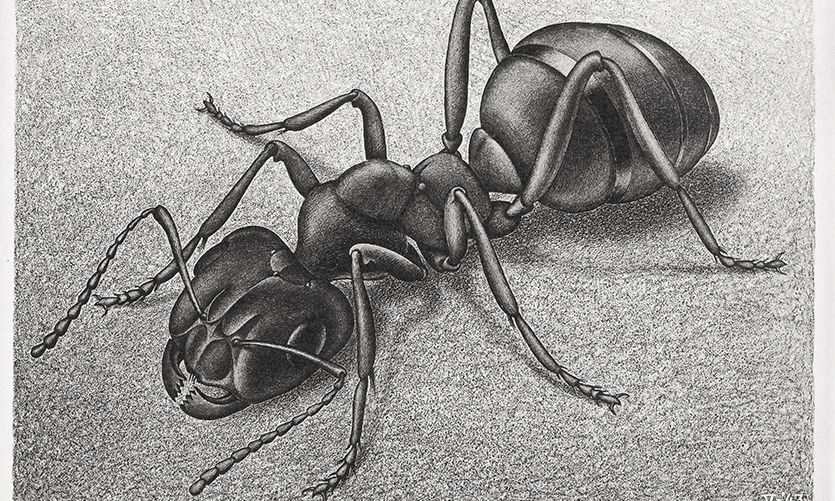M.C. Escher’s Ant (1943)
© Forum Auctions
The Dutch printmaker M.C. Escher is best known for his mind-bending images that often included optical illusions. However, Escher “was also obsessed with the natural world, and his investigations of insects, lizards, snakes etc are vital aspects of his oeuvre that he wove into his more fantastical creations”, says Alexander Hayter, the international head of department for Modern and contemporary art and editions at Forum Auctions. “The ant, for instance, is the cornerstone and starting point of one of his more well known images, Möbius Strip II (1963), a never-ending laddered loop of ants on an eternal march.” From an edition of 20, Ant is one of only three to have appeared on the open market in the past 30 years, Hayter says. “In terms of rarity, it is among, if not the rarest of his known graphic works and a work likely only made available to certain well thought of patrons.” The owner, now in his 90s, knew Escher as a young boy in Holland, visiting the artist regularly and spending his pocket money buying prints from him.
Botticelli and Studio, The Virgin and Child, with a landscape beyond (1490s)
Courtesy Sotheby’s
This virgin and child composition, framed within an architectural arch, is “an incredibly refined example of what Botticelli was producing in his late career”, says Elisabeth Lobkowicz, an Old Master paintings specialist at Sotheby’s London. In the 20th century, the work belonged to the banker Alfred de Rothschild in London, who bequeathed it to his daughter. Since then it has been sold several times, with the last sale at auction in 2001 by Sotheby’s in New York, when it was attributed in full to Botticelli and sold for $850,000. Its authorship has since been expanded to include his studio, although Sotheby’s lot essay says that “more recent opinions on the picture’s authorship have also been favourable, with some scholars considering it very likely executed in large part, if not entirely, by the master himself”.
The work underwent infrared scans in 2012, which revealed the painting’s underdrawing. “You can see shifts in the eyes, the placement of the fingers, as the artist was working through the nature of the composition,” Lobkowicz says. “To the naked eye, this is particularly visible in the architectural elements, such as the angles of the stone parapet, where you can really see how Botticelli was thinking about perspective, order and space.”
Tunji Adeniyi-Jones, Crimson Grin (2019)
Courtesy Phillips
The star of the young English artist Tunji Adeniyi-Jones, who is based in New York, is in ascent. His works, which are inspired by both his Yoruba heritage and diasporic experiences, regularly sell at auction for six figures. His appearance in the Nigerian Pavilion of this year’s Venice Biennale has further spurred his market. “The artist was concurrently featured in White Cube’s booth at Frieze New York [in May], and a painting by the artist at Christie’s Day Sale in New York [the same month] sold for over $100,000,” says Nina Piro, a specialist and associate vice president for Modern and contemporary art at Phillips.
The pocket-sized painting Crimson Grin is owned by a private collector in Florida and was acquired from Nicelle Beauchene Gallery in New York during Adeniyi-Jones’s solo exhibition in 2020, where the artist’s works depicted West African methods of worship, idolatry and myth. “At only 10in by 8in, this is the first time that a painting of this scale by the artist has come to auction,” Piro says. “Adeniyi-Jones is typically known for works on paper and editions, so it is a great opportunity for collectors interested in his wider practice to purchase a painting.”

